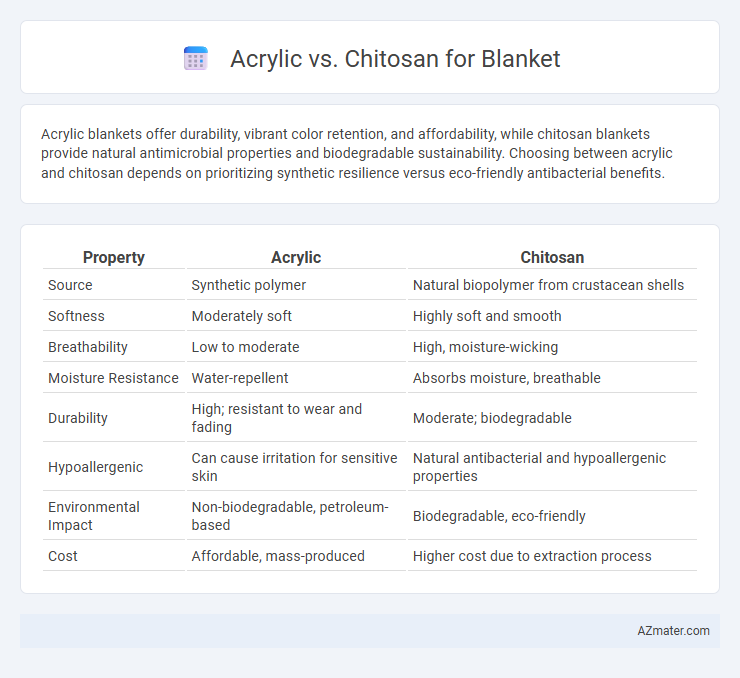Acrylic blankets offer durability, vibrant color retention, and affordability, while chitosan blankets provide natural antimicrobial properties and biodegradable sustainability. Choosing between acrylic and chitosan depends on prioritizing synthetic resilience versus eco-friendly antibacterial benefits.
Table of Comparison
| Property | Acrylic | Chitosan |
|---|---|---|
| Source | Synthetic polymer | Natural biopolymer from crustacean shells |
| Softness | Moderately soft | Highly soft and smooth |
| Breathability | Low to moderate | High, moisture-wicking |
| Moisture Resistance | Water-repellent | Absorbs moisture, breathable |
| Durability | High; resistant to wear and fading | Moderate; biodegradable |
| Hypoallergenic | Can cause irritation for sensitive skin | Natural antibacterial and hypoallergenic properties |
| Environmental Impact | Non-biodegradable, petroleum-based | Biodegradable, eco-friendly |
| Cost | Affordable, mass-produced | Higher cost due to extraction process |
Introduction to Acrylic and Chitosan Blankets
Acrylic blankets are synthetic, lightweight, and known for their durability, softness, and resistance to moths and mildew, making them a popular choice for warmth and easy maintenance. Chitosan blankets, derived from natural chitin found in shellfish, offer hypoallergenic and antibacterial properties alongside excellent moisture-wicking abilities, enhancing comfort and hygiene. Both materials present distinct benefits, with acrylic excelling in affordability and long-lasting softness, while chitosan provides natural, eco-friendly features suitable for sensitive skin.
Material Composition and Sources
Acrylic blankets are made from synthetic polymers derived from petrochemicals, offering durability and resistance to moisture and mildew, while chitosan blankets utilize a natural biopolymer extracted from the shells of crustaceans such as shrimp and crabs, known for their antibacterial and biodegradable properties. Acrylic fibers provide lightweight warmth and colorfastness, whereas chitosan integrates health benefits like odor control and enhanced skin compatibility. The contrasting material compositions underscore acrylic's reliance on fossil-fuel-based production versus chitosan's sustainable and renewable marine biomass origins.
Manufacturing Processes Compared
Acrylic blankets are typically produced through polymerization of acrylonitrile monomers followed by fiber extrusion and knitting or weaving, using energy-intensive synthetic processes. Chitosan blankets involve extracting chitosan from crustacean shells via deacetylation of chitin, then blending it with natural fibers before weaving or knitting, emphasizing biodegradability and sustainability. The manufacturing of chitosan blankets often requires specialized processing to maintain antimicrobial properties, contrasting with the large-scale synthetic fiber production of acrylic blankets.
Durability and Longevity Analysis
Acrylic blankets exhibit high durability due to their resistance to wear, moisture, and UV exposure, making them suitable for long-term use with minimal color fading or fiber breakdown. Chitosan blankets, derived from natural biopolymers, offer moderate durability but excel in biodegradability and antimicrobial properties, which may reduce lifespan compared to synthetic options. Comparing longevity, acrylic blankets typically outperform chitosan ones by maintaining structural integrity over extended periods under regular usage conditions.
Comfort and Softness Evaluation
Acrylic blankets offer a soft, lightweight texture that mimics wool, providing warmth and comfort while being hypoallergenic and easy to care for. Chitosan blankets, made from biopolymer fibers derived from chitin, boast natural antimicrobial properties and superior moisture-wicking abilities, enhancing comfort through breathability and maintaining skin dryness. In softness evaluation, acrylic tends to feel plush and smooth, whereas chitosan blankets deliver a gentle, silky touch combined with eco-friendly benefits, making them ideal for sensitive skin and sustainable choices.
Thermal Insulation Properties
Acrylic fibers provide excellent thermal insulation due to their lightweight structure and ability to trap air effectively, making them ideal for maintaining warmth in blankets. Chitosan, derived from natural biopolymers, offers moderate thermal insulation with the added benefits of moisture regulation and antimicrobial properties, enhancing blanket comfort and hygiene. When comparing thermal insulation performance, acrylic blankets generally retain heat more efficiently, while chitosan blankets balance insulation with breathability and ecological advantages.
Allergy and Skin Sensitivity Considerations
Acrylic blankets are synthetic and may cause irritation or allergic reactions in individuals with sensitive skin due to chemical fibers. Chitosan blankets, derived from natural shellfish sources, offer hypoallergenic properties and antimicrobial benefits, making them suitable for allergy sufferers. Choosing chitosan blankets can reduce skin sensitivity issues, especially for those prone to eczema or dermatitis.
Eco-Friendliness and Biodegradability
Chitosan blankets offer superior eco-friendliness and biodegradability compared to acrylic blankets, as chitosan is derived from natural sources like crustacean shells and decomposes quickly without leaving harmful residues. Acrylic blankets, made from synthetic polymers, contribute to microplastic pollution and take centuries to break down in landfills, posing long-term environmental challenges. Opting for chitosan-based blankets supports sustainable living by reducing synthetic waste and promoting renewable materials.
Cost-Effectiveness and Market Availability
Acrylic blankets tend to offer greater cost-effectiveness due to lower production expenses and widespread manufacturing, resulting in competitive pricing for consumers. Chitosan blankets, while pricier due to their biodegradable nature and complex extraction process, provide unique antimicrobial benefits that appeal to niche markets prioritizing sustainability and health. Market availability favors acrylic blankets with extensive distribution channels, whereas chitosan blankets remain less accessible, primarily sold through specialized eco-friendly retailers.
Choosing the Right Blanket: Acrylic vs Chitosan
Choosing the right blanket involves comparing the benefits of acrylic and chitosan fibers, where acrylic offers affordability, lightweight warmth, and easy care, while chitosan provides natural antimicrobial properties and enhanced moisture-wicking comfort. Acrylic blankets are known for their durability and resistance to moths, making them ideal for low-maintenance use. In contrast, chitosan blankets support better hygiene and skin health due to their bioactive properties, suitable for sensitive skin and allergy concerns.

Infographic: Acrylic vs Chitosan for Blanket
 azmater.com
azmater.com